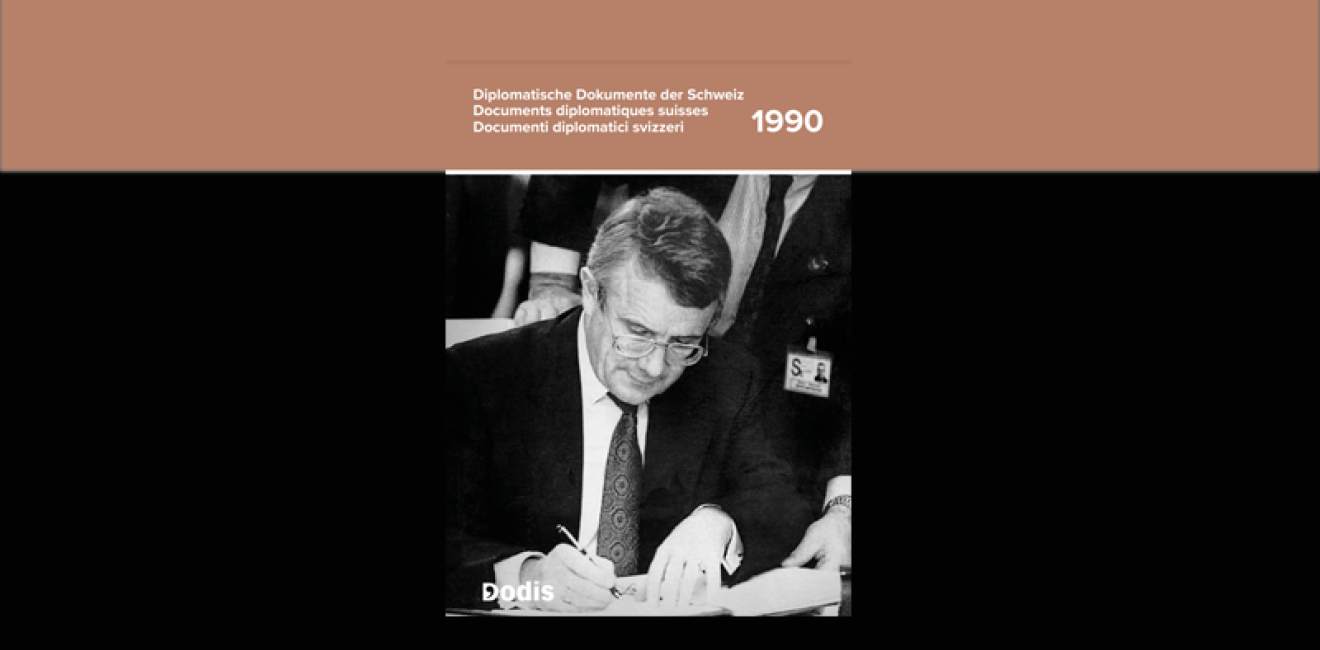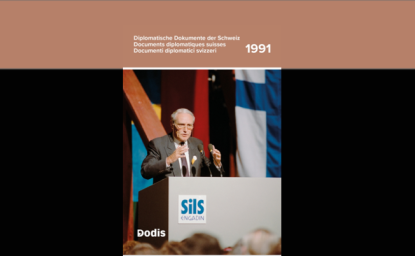The Year 1990 in Swiss Diplomatic Documents
Liliane Stadler offers a look at the latest release of documents from Diplomatische Dokumente der Schweiz (Dodis), which covers the year 1990 in Swiss diplomatic history.

A blog of the History and Public Policy Program
Liliane Stadler offers a look at the latest release of documents from Diplomatische Dokumente der Schweiz (Dodis), which covers the year 1990 in Swiss diplomatic history.

In January of 2021 – the moment the Thirty-Year Rule of classification ceased to apply – the research team at Diplomatische Dokumente der Schweiz (Dodis) published its latest volume of Swiss diplomatic documents from the year 1990. Not only have these documents recently been declassified, they have also been published almost simultaneously, which is a remarkable achievement by most standards. The German Institute for Contemporary History and the British Foreign, Commonwealth & Development Office have also recently released their respective volumes on 1989. Overall, Dodis’ new volume covers 284 pages, 62 primary source documents and it is written in three of Switzerland’s four national languages. Sources have been thoughtfully transcribed, referenced, and, where appropriate, accompanied by relevant links to Dodis’ online repository and research guides.
As with most archival primary source publications, the purpose of this volume is to inform the public and to support researchers at various stages of their careers by building awareness of the holdings of the Swiss Federal Archives. Whether for an undergraduate essay, a research grant proposal, or simply out of curiosity, the Edition Diplomatische Dokumente der Schweiz (DDS), is intended to inspire interest and research into the history of Switzerland’s foreign relations, its diplomatic institutions, and the international and transnational issues that have driven Swiss foreign policy in the past. The documents contained in the present volume on 1990 include briefing papers, meeting minutes, diplomatic correspondence, speeches, situation analyses, and policy papers, among other documents.
Many of the documents touch on issues related to other states and intergovernmental organizations such as the United Nations (UN) and the Bretton Woods institutions. As such, they might also be of interest to researchers who are seeking to triangulate source material on other countries, but who cannot yet access the necessary archival documents. For instance, Dodis’ selection includes briefings and bilateral meeting minutes between Swiss diplomats and high-level representatives from Mexico, Poland, Nepal, Denmark, Italy, Brazil, Madagascar, and Japan. The collection even includes the minutes of a visit by Nelson Mandela himself.
Dodis’ selection is also valuable for those interested in researching particular themes of late Cold War and contemporary diplomatic history, including the end of the Cold War, the Paris Charter of the Conference on Security and Cooperation in Europe (CSCE), the largely peaceful transitions in Eastern Europe, and contemporary steps towards European integration. An excerpt from the meeting minutes of the parliamentary committee on foreign affairs of the National Assembly details a number of concerns that the Swiss shared with the rest of the world at the time and which continue to preoccupy Swiss government and non-governmental actors today. On 12 February, 1990, the committee narrowed its most prominent concerns down to three points: Globalization, interdependence and economic growth (p. 51 of the Dodis volume).
As the volume reiterates at several stages, most policymakers were taken by surprise both by the pace of political change in Central and Eastern Europe between 1989 and 1990, as well as by the relative peacefulness with which it took place. Yet, as an excerpt from an internal memorandum on the two Germanies makes clear, the Swiss were aware of the potential social and economic problems that might follow in the wake of German reunification (p.183).
Perhaps the most important question for the Swiss government at the time was how East-West reconciliation would affect European integration and what position the Swiss ought to adapt as a consequence. As a number of documents in the present volume clearly show, there was no agreement and no solid perspective on this point. As such, one might argue that this particular issue has had long-lasting repercussions to this day, as the Swiss foreign ministry struggles to define the nature of its relationship with the European Union. There was, however, as the minutes of a ministerial meeting from 19 February, 1990 suggest, agreement at the time among the members of the Federal Council that membership of the European Economic Area (EEA) was actually desirable (p. 39).
A final issue of particular significance to Swiss foreign policy in 1990 was that of neutrality. Switzerland has become known both for being the oldest and arguably the strictest neutral among permanently neutral states. Yet in 1990, the Swiss government decided to participate in a UN sanctions regime against Iraq in response to the latter’s invasion of Kuwait. This was the first time that the Swiss government participated in multilateral sanctions and it stirred a heated debate among the Swiss public about Swiss neutrality.
Dodis’ selection of documents shows that prior to the Swiss government’s decision to support the sanctions global developments surrounding the end of the Cold War had caused the Foreign Ministry to reflect on the nature of Swiss neutrality in general. Would Swiss neutrality make a difference to the European balance of power in the future, policymakers asked themselves, and would this be an obstacle to joining the European Union? As had been the case during the early post-war period and in the aftermath of the 1986 referendum on UN membership, policymakers were forced to reflect on the credibility of Swiss neutrality viewed both from home and from abroad.
Reading through the Dodis volume, there might be some who would remark that it does not contain any newspaper clippings from 1990 and that it does not specifically include correspondence from other governments, from non-governmental organizations, or private citizens to the Swiss authorities. Nor does the volume include documents that are translated into English, but this is not necessarily a weakness. First, director of the Dodis research group Sacha Zala makes the scope of the collection quite clear in the volume’s multilingual introductory remarks. Second, Dodis’ efforts to redirect researchers to additional source material are both incredibly detailed and extensive. Researchers interested in pursuing further sources can easily access 1,500 further documents from 1990 and their associated metadata on the Dodis website – which can be navigated in English – or by an in-person visit the Swiss National Archives.


A leader in making key foreign policy records accessible and fostering informed scholarship, analysis, and discussion on international affairs, past and present. Read more



